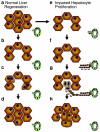Activation of stem cells in hepatic diseases
- PMID: 18046579
- PMCID: PMC3034134
- DOI: 10.1007/s00441-007-0542-z
Activation of stem cells in hepatic diseases
Abstract
The liver has enormous regenerative capacity. Following acute liver injury, hepatocyte division regenerates the parenchyma but, if this capacity is overwhelmed during massive or chronic liver injury, the intrinsic hepatic progenitor cells (HPCs) termed oval cells are activated. These HPCs are bipotential and can regenerate both biliary epithelia and hepatocytes. Multiple signalling pathways contribute to the complex mechanism controlling the behaviour of the HPCs. These signals are delivered primarily by the surrounding microenvironment. During liver disease, stem cells extrinsic to the liver are activated and bone-marrow-derived cells play a role in the generation of fibrosis during liver injury and its resolution. Here, we review our current understanding of the role of stem cells during liver disease and their mechanisms of activation.
Figures




Similar articles
-
Hepatic Progenitor Cells in Action: Liver Regeneration or Fibrosis?Am J Pathol. 2015 Sep;185(9):2342-50. doi: 10.1016/j.ajpath.2015.06.004. Epub 2015 Aug 6. Am J Pathol. 2015. PMID: 26255773 Review.
-
Hepatic stem and progenitor cells in liver diseases and hepatocarcinogenesis.Minerva Gastroenterol Dietol. 2009 Jun;55(2):111-21. Minerva Gastroenterol Dietol. 2009. PMID: 19305371 Review.
-
Hepatic progenitor cells in liver regeneration: current advances and clinical perspectives.Liver Int. 2014 Nov;34(10):1464-72. doi: 10.1111/liv.12573. Epub 2014 May 14. Liver Int. 2014. PMID: 24750779 Review.
-
Stem cells in liver regeneration, fibrosis and cancer: the good, the bad and the ugly.J Pathol. 2009 Jan;217(2):282-98. doi: 10.1002/path.2453. J Pathol. 2009. PMID: 18991329 Review.
-
Characterisation of a stereotypical cellular and extracellular adult liver progenitor cell niche in rodents and diseased human liver.Gut. 2010 May;59(5):645-54. doi: 10.1136/gut.2009.182345. Gut. 2010. PMID: 20427399 Free PMC article.
Cited by
-
Bone Marrow-Derived Mesenchymal Stem Cells Isolated from Patients with Cirrhosis and Healthy Volunteers Show Comparable Characteristics.Int J Stem Cells. 2020 Nov 30;13(3):394-403. doi: 10.15283/ijsc20072. Int J Stem Cells. 2020. PMID: 32840228 Free PMC article.
-
COMMD1-deficient dogs accumulate copper in hepatocytes and provide a good model for chronic hepatitis and fibrosis.PLoS One. 2012;7(8):e42158. doi: 10.1371/journal.pone.0042158. Epub 2012 Aug 6. PLoS One. 2012. PMID: 22879914 Free PMC article.
-
Liver development, regeneration, and carcinogenesis.J Biomed Biotechnol. 2010;2010:984248. doi: 10.1155/2010/984248. Epub 2010 Feb 7. J Biomed Biotechnol. 2010. PMID: 20169172 Free PMC article. Review.
-
FGF7 is a functional niche signal required for stimulation of adult liver progenitor cells that support liver regeneration.Genes Dev. 2013 Jan 15;27(2):169-81. doi: 10.1101/gad.204776.112. Epub 2013 Jan 15. Genes Dev. 2013. PMID: 23322300 Free PMC article.
-
Tracking iron oxide labelled mesenchymal stem cells(MSCs) using magnetic resonance imaging (MRI) in a rat model of hepatic cirrhosis.Bioinformation. 2019 Jan 31;15(1):1-10. doi: 10.6026/97320630015001. eCollection 2019. Bioinformation. 2019. PMID: 31359992 Free PMC article.
References
-
- Abe S, Lauby G, Boyer C, Rennard SI, Sharp JG. Transplanted BM and BM side population cells contribute progeny to the lung and liver in irradiated mice. Cytotherapy. 2003;5:523–533. - PubMed
-
- Akhurst B, Matthews V, Husk K, Smyth MJ, Abraham LJ, Yeoh GC. Differential lymphotoxin-beta and interferon gamma signaling during mouse liver regeneration induced by chronic and acute injury. Hepatology. 2005;41:327–335. - PubMed
-
- Alison M. Liver stem cells: a two compartment system. Curr Opin Cell Biol. 1998;10:710–715. - PubMed
-
- Alison MR. Liver stem cells: implications for hepatocarcinogenesis. Stem Cell Rev. 2005;1:253–260. - PubMed
-
- Alison MR, Poulsom R, Jeffery R, Dhillon AP, Quaglia A, Jacob J, Novelli M, Prentice G, Williamson J, Wright NA. Hepatocytes from non-hepatic adult stem cells. Nature. 2000;406:257. - PubMed
Publication types
MeSH terms
Grants and funding
LinkOut - more resources
Full Text Sources
Other Literature Sources
Medical

